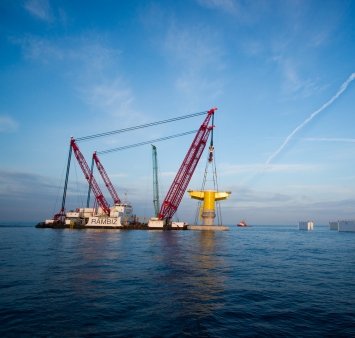newsflash
Only a few days after the first Gravity Based Foundation was installed, the project team of Jan De Nul Group floated off and installed the second and even larger GBF for the offshore wind farm Kriegers Flak in Denmark. The weather was favourable and the installation operation of this 10,000 tonnes masterpiece went according to plan.
The barge containing the GBF submerged, the heavy lift vessel Rambiz connected to the GBF through its crane hooks and towed out the structure once it started to float. An assisting tug subsequently towed the Rambiz together with the structure to its final installation location where the vessel in combination with an in-house designed ballast module set the structure down onto the seabed.
Both GBFs have been installed on a gravel bedding layer which has been accurately prepared by Jan De Nul Group’s most recent multipurpose vessel Adhémar de Saint-Venant. As a result, this structure has been set down within a vertical accuracy of 0.01 degrees. A high-precision job under water.
The Adhémar de Saint-Venant will now start with the ballasting of the structures and the scour protection works around them.
About the Kriegers Flak Contract of Jan De Nul Group and Smulders
Jan De Nul Group and Smulders joined forces to build two Gravity Based Foundations (GBFs) for the high voltage station of the Danish offshore wind farm Kriegers Flak. Both foundations consist of a concrete part (GBF) and a steel structure on top. Jan De Nul Group was responsible for the design and construction of the concrete GBFs, while Smulders took care of the design and construction of the steel shafts and decks placed on top. Jan De Nul Group is in charge of the installation of both GBFs, the ballasting and the placement of scour protection in the offshore wind farm Kriegers Flak in Denmark.
About the wind farm
The Danish wind farm Kriegers Flak, located in the Baltic Sea, consists of two sites: Kriegers Flak A, the Western section, with a total capacity of 200 MW, and the Eastern section, Kriegers Flak B, with a total capacity of 400 MW. Each section will dispose of its own substation, serving both for the future Krieger Flaks offshore wind farm as well as an interconnector between the Danish and German power net. By 2022, Denmark's to date largest offshore wind farm will start generating CO2-free electricity for approx. 600,000 households. The interconnector project is funded by the European Energy Programme for Recovery.











